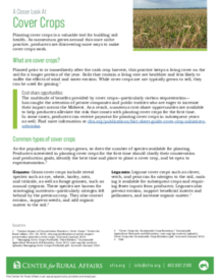Planting cover crops is a valuable tool for building soil health. As momentum grows around this once niche practice, producers are discovering more ways to make cover crops work.
What are cover crops?
Planted prior to or immediately after the cash crop harvest, this practice keeps a living cover on the soil for a longer portion of the year. Soils that contain a living root are healthier and less likely to suffer the effects of wind and water erosion. While cover crops are not typically grown to sell, they can be used for grazing.
Cost-share opportunities
The multitude of benefits provided by cover crops—particularly carbon sequestration—has caught the attention of private companies and public entities who are eager to increase their impact across the Midwest. As a result, numerous cost-share opportunities are available to help producers alleviate the risk that comes with planting cover crops for the first time. In some cases, producers can receive payment for planting cover crops in subsequent years as well.


